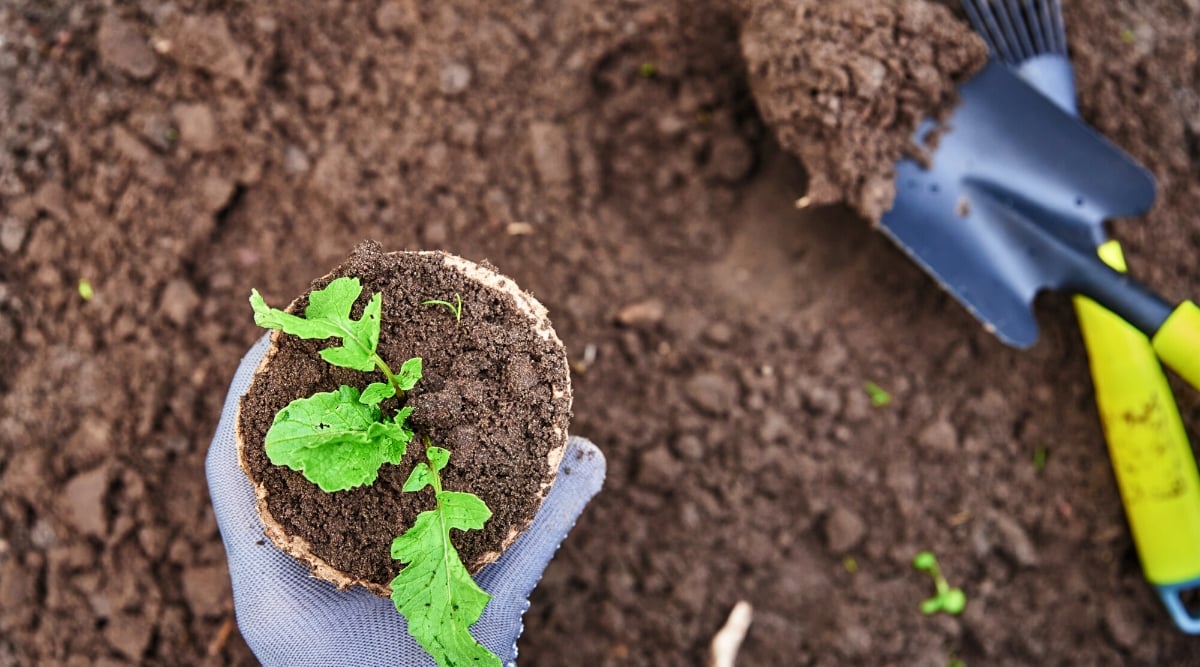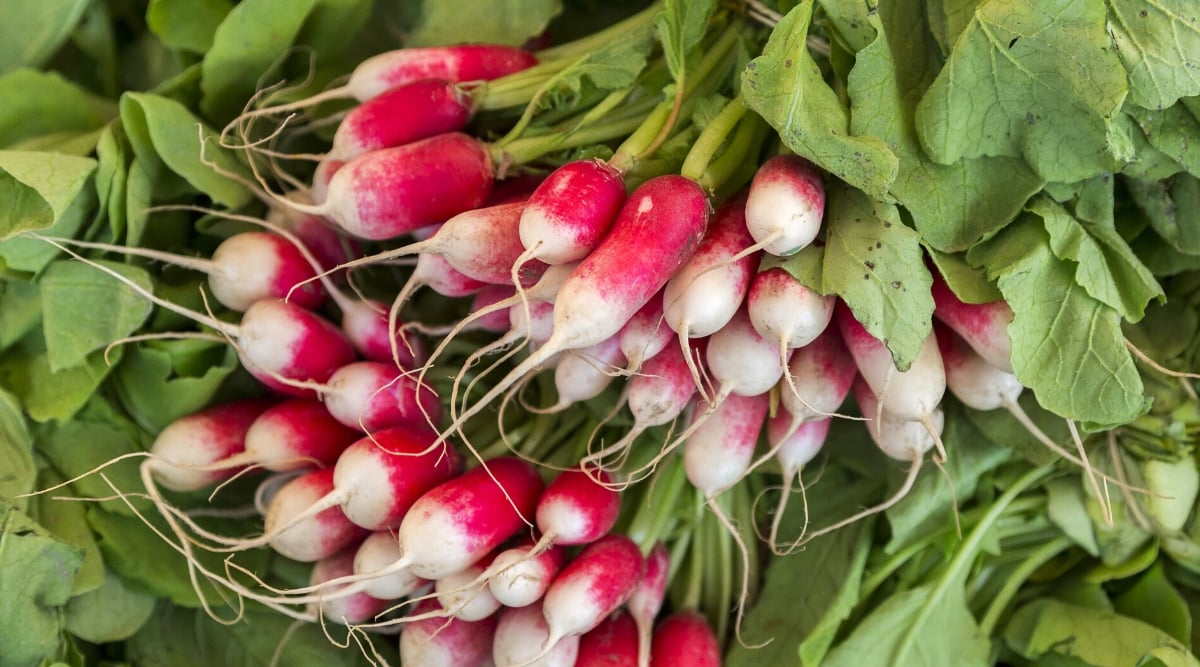10 Tips for Growing Radishes in Pots or Containers
Radishes are a fun and easy crop from seed to harvest. Try them in containers for a fast-germinating portable veggie option you can grow anywhere. In this article, we’ll tell you what you need to know to grow epic radishes in containers!

Contents
My kids love to harvest radishes. Pulling them out of the soil is a joyful task, and even more fun when you plant different varieties to get a color surprise.
Radishes are generally a cool season crop, but growing in containers gives you the flexibility to move them out of the harshest sun of the day, extending your season. They’re also perfect to grow in pots or trays indoors as nutrient-dense microgreens!
Radish is a dependable and fast-maturing root veggie that’s delicious roasted, thinly sliced in pasta and salads, or even raw with a little butter and salt. Follow along for all you need to know to grow tasty radishes in containers!
Pick the Right Container
Radishes can be tucked into raised bed rows (try them to deter squash bugs!) or in their own pots. Keep these considerations in mind when choosing a container:
Size

Most radish varieties need a container at least 6 inches deep to develop a good-looking root, while big ones like Daikon will need a depth of at least 2 feet.
Any width will work, but smaller containers limit how many you can plant. An average 12-inch diameter pot can hold around 6 radishes. If you’d like to grow them in a large raised bed or container, plan to space them approximately 2-3 inches apart (or sow 1 inch apart and thin them later).
Drainage

Radishes like to be kept consistently moist, but will not do well in soggy soil. Make sure your chosen container has drainage holes, or drill them yourself.
Your choice of container might be influenced by the time of year, available space, and your growing conditions. Remember- they like cool weather. If you’ve planted in summer and temps are starting to heat up, try a portable container you can move to a shady spot in the afternoons.
Try Epic Grow Bags, a sturdy and portable grow bag option that pairs perfectly with moisture-retentive potting mix to create the ideal aeration conditions for your radishes. They have nice thick handles for carrying around, and come in a pack of 5 (try carrots and turnips in them too!).
If you’re on the hunt for a raised bed option, look at Birdies Metal Raised Beds. They’re sustainably produced and 30 inches tall, which gives you plenty of space to plant larger radish varieties like Daikon.
Radish is awesome as a quick microgreen indoors. For this, you can use a smaller tray since you’re only harvesting the greens.
Plant at the Right Time

Radishes do best planted in the cool temperatures of spring and fall. In spring, you can seed them as soon as the soil can be worked (around 40℉). In the fall, plant about 6-8 weeks before your last expected frost.
They’ll grow best between 55-70℉ and will start to struggle when temps exceed 80℉. You can grow them indoors or year-round, provided you have a sunny window or grow lights.
They’ll mature in as little as 4 weeks, depending on the variety. You can succession sow every couple of weeks throughout the cool seasons for a consistent crop.
In my climate, I like to grow radishes in early spring, take a break from them in the midsummer heat, and plant again for a new crop in fall.
Choose the Right Site

Radishes grow best with 6-8 hours of direct sun, as long as the temperatures are cool. They prefer some shade in hot climates. If your temps exceed 80 degrees, keep them mostly shaded, with 3-4 hours of sun. The shade will slow their growth slightly, but you’ll still get a good crop!
Planting in containers will let you stay flexible, moving them indoors if the heat is causing them to bolt (ie. flower and set seeds, making the root flavorless).
You can also plant them in raised beds near taller plants, which will slightly shade them. Try cucumbers or eggplants, which also benefit from the pest-repelling properties of radishes. Bye bye, cucumber beetles!
Give Them Good Soil

Radish is a root vegetable, so it needs loose soil for unobstructed growth below the ground. Raised beds and containers are ideal for their ability to control soil texture and nutrients.
Use a good-quality potting mix with a neutral pH of 6.5-7 and cover it with an inch of organic compost. If the soil in your raised beds is compacted or heavy, amend it with horticultural sand or perlite to loosen things up and facilitate drainage.
Once planted, keep the soil moist by adding an inch or two of mulch, like straw or wood chips. A layer of mulch also keeps soil cooler to reduce heat stress on the radishes.
Choose The Right Variety
I love playing around with different types of radishes in the garden. Some can handle a bit more heat, while others need to be planted only in winter, fall, or spring cool temps. They come in different shapes, colors, and tastes, too!
Here are a few varieties I recommend:
French Breakfast

French Breakfast radishes are an heirloom favorite ready to eat in 30 days! They’ll withstand a bit more heat than other varieties, so I like them for late spring planting in my 5b climate. They are oblong and strawberry pink with white tips. These are wonderful for those who like a milder flavor.
Cherry Belle

Cherry Belle radishes are cherry red with crispy white interiors. They’re ready to harvest in a few weeks. They have an excellent round shape and a tang that’s great for eating fresh or in salads.
Easter Egg

Turn harvesting radishes into a treasure hunt with the fun colors of this Easter Egg blend, which will give you roots in purple, white, red, pink, and red/white combos. These radishes are globe-shaped and ready in 30 days.
Miyashige White Daikon

With spicy flavor and enormous roots up to 18 inches long, Miyashige White Daikon is a different and delicious choice. These are considered winter radishes and need shorter day lengths with cool temps to perform. As a bonus, the large roots break up and feed compacted soils! Eat them or use them as a fall cover crop.
Sow the Seeds

Radishes grow quickly, and like most root veggies, are best direct-sown. When planting in containers, you can sow radish seeds in a couple of different ways. I prefer to sow mine intensely, scattering seeds into a row without counting. I then thin them out to 2-3 apart after a week.
You can also seed them about 2 inches apart and let them naturally push each other away. Either way, sow seeds about ½ inch deep.
If you’ve grown them indoors and want to transplant them out, try to minimize root disturbance. Turn your cell trays upside down and gently squeeze until they slide out. Plant them a couple of inches apart.
Water the Right Amount

Keeping your radish seeds moist is crucial until germination, in 3-7 days. After that, water them consistently daily, never letting them dry out completely. Dry soil leads to cracked radish roots.
The amount of water you need will depend on your temperatures and soil consistency. Keep in mind that soil in containers dries out more quickly, and check it often, especially in hot temperatures.
It’s best to check the actual soil rather than sticking to a rigid schedule. Waterlogged soil can lead to rotted radishes, but if it’s too dry, you won’t have good radishes either! Test the soil frequently with your fingers and water whenever it’s dry.
Fertilize (or Don’t)

Radishes really don’t need fertilization, provided you’ve used a high-quality potting mix and some compost. Avoid any fertilizers high in nitrogen, which fosters more green leafy growth. We’re after tasty roots in this case!
If you want to fertilize, try a low-nitrogen, heavy-potassium organic fertilizer like a kelp meal. This will keep the radishes sweet and crispy rather than woody and direct energy to the roots.
Watch For Pests and Diseases
The peppery flavor and earthy smell of radishes repel many pests, and they are not particularly susceptible to disease. Here are a few you might spot and what to do about them:
Aphids

Some species of these soft-bodied little sap-suckers like radish greens. Hit them with a direct spray from the hose for quick removal. Also, consider planting nasturtium, a trap plant that will lure the aphids away from your desired plants, or plant herbs like dill and catnip that repel them nearby.
Flea Beetles

Flea beetles are shiny black insects that will eat the leaves and the roots of radishes. They have some of the same predators as aphids and can be attracted via companion planting.
If flea beetles are a consistent struggle, buy a floating row cover and cover your crops as a preventative. You can also coat radishes with kaolin clay, which is purchased as a soft white mineral powder that creates a barrier against beetles and other pests.
Downy Mildew

This is a type of fungus that shows up as leaves with yellow and white splotches. A cottony growth may show up on leaf undersides. It can cause the radish roots to decay or develop lesions. Downy mildew likes cool, moist conditions.
Prevent it by keeping radishes spaced at least a couple of inches apart for good airflow and water at the roots rather than overhead. Since the fungus can overwinter in the soil, don’t plant more radishes (or other brassicas) in the same spot next year.
Harvest

Here’s the best part! Depending on the variety, you can start harvesting your radishes in as little as 3-4 weeks. Larger varieties, like Daikon, need between 60-70 days and sometimes longer. Keep track of when you planted them, as you don’t want to miss the optimal harvesting window. If left too long and allowed to flower, the roots will be woody and tasteless.
About a week prior to their estimated harvest date, gently loosen the soil and pull straight up or use a digging fork to unearth a radish. If it looks good, go ahead and harvest! If it’s still small, wait a week and check again.
I like to leave a few of my radish plants to bolt and set seed, which I collect to grow again next year. Don’t miss out on the greens, too, which you can cook when mature or eat raw when young. They don’t store well, so plan on using them right away.
Final Thoughts
Radishes are easy to grow and a tasty addition to your veggie repertoire. They’re also good for you, with a high amount of vitamin C and fiber. Best of all, they grow so quickly that they provide almost instant gratification! Try radishes in containers this year to give you a good crop, even if you’re working with limited space or poor soil conditions.








